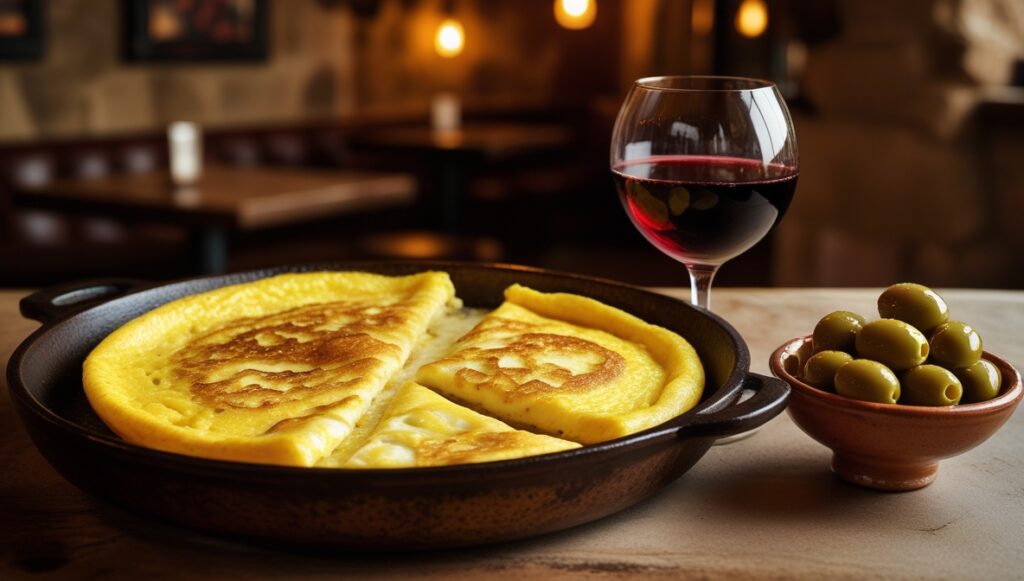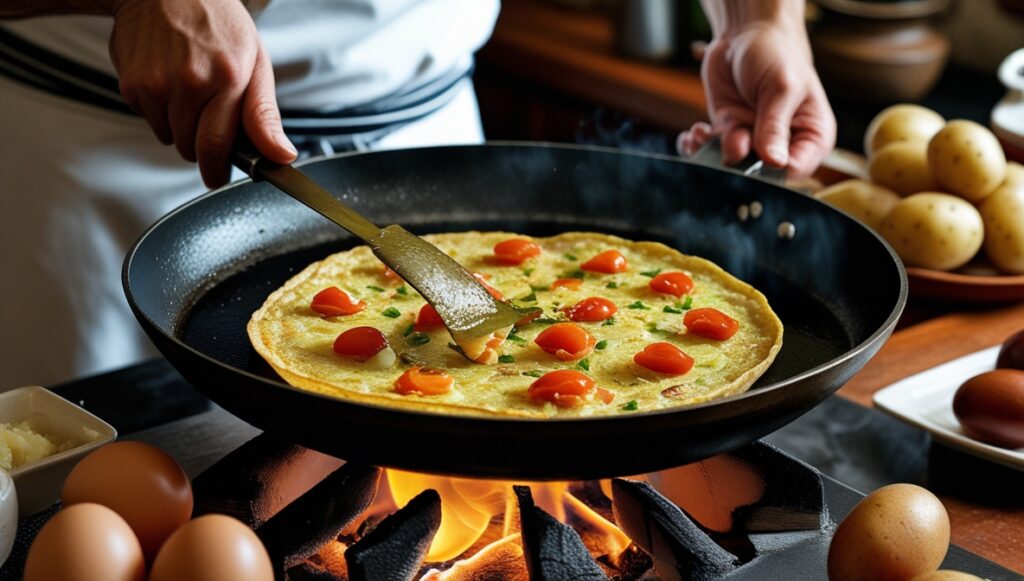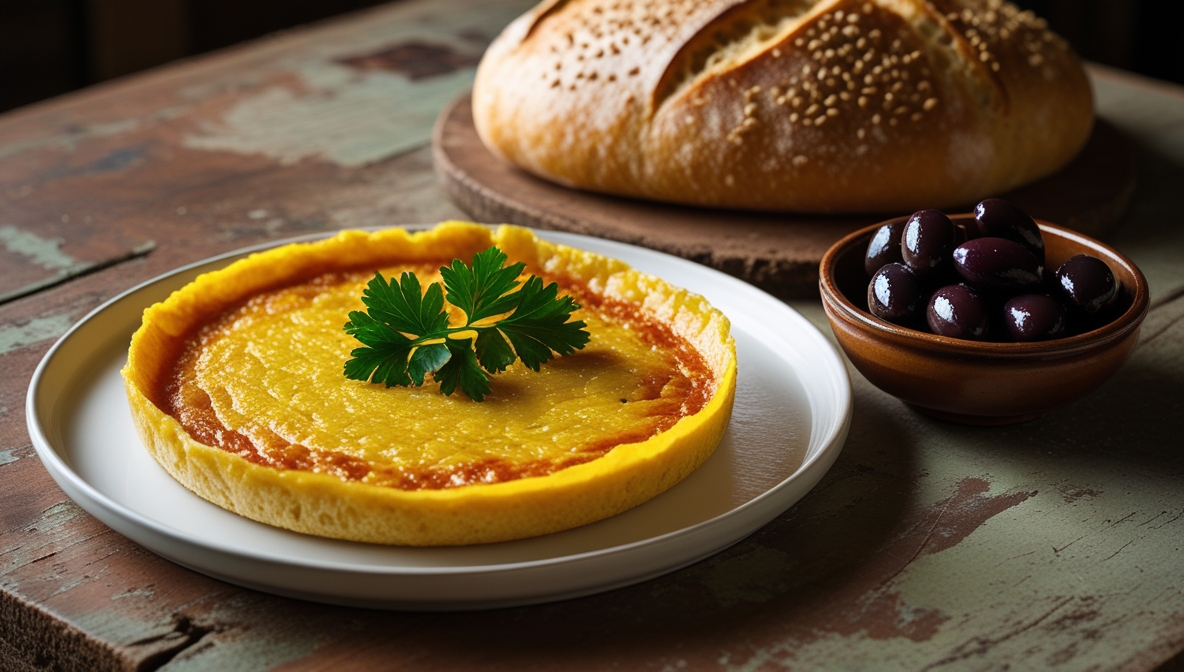Introduction
Golden, hearty, and deeply satisfying — Tortilla Española (Spanish Omelette) is a dish that transcends time and trends. Found in every corner of Spain, from rustic village taverns to sleek tapas bars, it is a national treasure that represents the soul of Spanish home cooking.
Loved for its simplicity and versatility, Tortilla Española is more than just eggs and potatoes. It’s comfort food, a shared memory across generations, and a cultural symbol that captures Spain’s rich culinary identity.


History & Cultural Significance
The exact origins of Tortilla Española remain a topic of debate, but its roots likely trace back to the early 19th century, particularly in the region of Navarre. One popular legend claims that General Tomás de Zumalacárregui created the dish during the First Carlist War as a quick, nourishing meal for his troops, using easily available ingredients.
Over time, Tortilla Española became a household staple, eventually woven into the fabric of Spanish culture. Tortilla Española now a key feature at family dinners, picnics, national holidays, and tapas bars across the country.
Tortilla Española also plays a central role in local cooking contests and is frequently served during festivals, such as La Tomatina in Buñol or Feria de Abril in Seville.
Ingredients & Regional Variations
Key Ingredients:
-
Eggs
-
Potatoes (traditionally waxy ones like Monalisa or Yukon Gold)
-
Olive oil
-
Salt
Optional Additions:
-
Onions (this addition often sparks passionate debates!)
-
Garlic
-
Peppers or chorizo (in some regional versions)
Regional Variations:
-
With or without onions (con cebolla vs. sin cebolla) — a national debate.
-
In Galicia, some versions include ham or seafood.
-
Catalonia may offer mini tortillas (tortilla de patatas individuales) in tapas form.
-
Modern versions include zucchini, spinach, goat cheese, or even truffle oil.
Cooking Process & Difficulty Level

Difficulty:
Moderate – It’s beginner-friendly with attention to timing and flipping technique.
Step-by-Step Cooking Guide
-
Slice potatoes thinly and optionally chop onions.
-
Fry in olive oil on medium heat until soft, not crispy.
-
Beat eggs and mix with the cooked potatoes/onions.
-
Pour mixture back into the pan, cook on low heat.
-
When semi-set, flip with a plate or lid to cook the other side.
-
Let it rest before slicing.
Optional: serve warm or at room temperature.
Where to Eat Tortilla Española in Spain
Top Spots to Taste Authentic Tortilla Española:
-
Casa Dani (Madrid) – Famous for its juicy, onion-rich tortilla.
-
Bar Néstor (San Sebastián) – Serves only one tortilla a day — get there early!
-
Juana La Loca (Madrid) – Known for modern gourmet twists.
-
Cal Pep (Barcelona) – A tapas institution with flavorful tortillas.
-
Tortilla de Patata de Betanzos (Galicia) – Known for ultra-runny style.
Even Michelin-starred restaurants like El Celler de Can Roca have reimagined the dish in fine-dining formats.
Pairing with Drinks & Side Dishes
Best Drinks:
-
Red or white Rioja wine
-
Cava (Spanish sparkling wine)
-
Tinto de Verano (red wine with soda)
-
Light beer or vermouth
Ideal Side Dishes:
-
Fresh tomato salad with olive oil and sea salt
-
Pan con tomate (bread rubbed with tomato)
-
Olives, chorizo, or jamón ibérico as tapas pairings
Fun Facts & Lesser-Known Trivia
-
The “onion vs. no onion” debate is so fierce that it has trended on Spanish Twitter under #ConCebolla and #SinCebolla.
-
In Spain, tortilla refers to this dish — not the flatbread used in Mexican cuisine.
-
Some chefs prepare “tortilla líquida”, a nearly raw center that melts in your mouth.
-
Picasso and Dalí were fans of the dish, often requesting it in Parisian restaurants.
Health Benefits & Nutrition
Nutrition:
-
Rich in protein (eggs)
-
Provides potassium and fiber (potatoes)
-
High in healthy fats when cooked with olive oil
Dietary Options:
-
Gluten-free by default
-
Can be made vegetarian or low-carb (with zucchini instead of potatoes)
-
Vegan version: Replace eggs with chickpea flour, black salt, and water for an “eggless” tortilla
How to Cook It at Home (Best Tortilla Española Recipe)
Ingredients:
-
4 medium potatoes, thinly sliced
-
1 small onion (optional), chopped
-
6 eggs
-
Salt to taste
-
Olive oil for frying
Method:
-
Fry potatoes and onions in olive oil until soft (about 10–15 minutes).
-
Drain and mix with beaten eggs and a pinch of salt.
-
Pour into a non-stick skillet, cook on low heat until the bottom sets.
-
Flip using a plate, cook the other side for 3–5 minutes.
-
Rest for 10 minutes before serving.
Tips:
-
Use a non-stick or well-seasoned skillet.
-
Let the egg mixture sit for a few minutes before cooking for richer flavor.
-
For a runny center, reduce cooking time slightly.
Global Influence & Fusion Cuisine
Tortilla Española has made its mark around the world:
-
Latin America: Influenced egg-and-potato dishes like tortilla de papas in Argentina.
-
Japan: Fusion chefs serve tortilla-inspired tamagoyaki rolls.
-
USA & UK: Common in brunch menus, often topped with aioli or arugula.
Creative adaptations include mini tortilla muffins, tortilla sandwiches, and even tortilla sushi rolls for tapas.
Comparison with Similar Dishes
-
Frittata (Italy)
-
Baked instead of pan-fried.
-
Often includes cheese, meats, and vegetables.
-
Cooked slowly in the oven or finished under a broiler.
-
-
Quiche (France)
-
Made with eggs, cream or milk, and various fillings.
-
Baked in a pastry crust.
-
Texture is creamier and more custard-like.
-
-
Tamago / Tamagoyaki (Japan)
-
Japanese sweet rolled omelette.
-
Contains sugar, mirin, and dashi (stock).
-
Cooked in a rectangular pan and served in layers.
-
-
Hashbrown Casserole (USA)
-
Includes shredded potatoes, cheese, sour cream, and sometimes soup mix.
-
Baked in a casserole dish.
-
Richer, cheesier, and more decadent.
-
-
Spanish-Style Tortilla Wrap (Global)
-
Inspired by the name but unrelated to the traditional dish.
-
Uses flatbread for wraps or burritos — a completely different concept.
-

